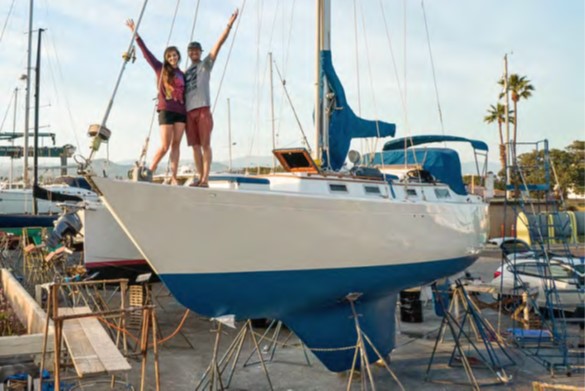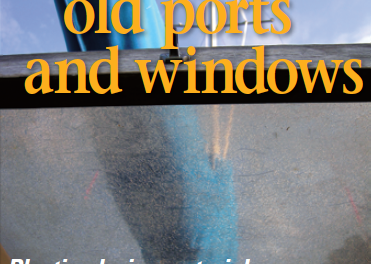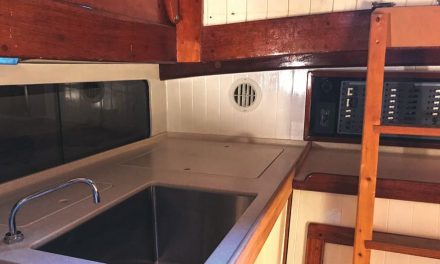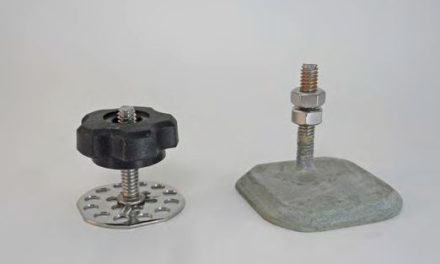Great modifications make all the difference on three good old boats.
Issue 141: Nov/Dec 2021
Spend any meaningful amount of time aboard a boat, and its shortcomings quickly become apparent. That wet locker you thought would get so much use? Junk accumulator. The second head, which at first seemed so wonderfully decadent? Ditto. The nifty heating system? Never works when you really need it. The boat’s interior, which seemed so well laid-out, and shined with polished mahogany? A game of Twister to navigate, frequently too dark, with nowhere to sit comfortably or put stuff.
In the relatively small spaces aboard a sailboat, where we are pared to our essence, such deficiencies can’t be ignored. The modifications we make say a lot about our priorities and needs. Sometimes these are major projects, yet at other times, it’s the simplest changes that can make life aboard more comfortable. Following are some modifications large and small from three good old boats whose owners were happy to discuss their projects via email.
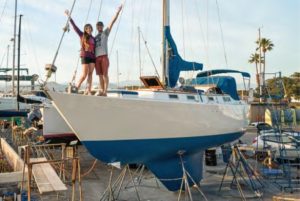
Marissa and Chris Neely aboard the boat they’ve steadily upgraded and improved since moving aboard in 2018.
Avocet
Chris and Marissa Neely keep Avocet, a 1979 Cheoy Lee 41, in Ventura, California. A few of the projects they’ve tackled include redesigning the boat’s head, an extensive galley refit with quartz countertops (Marissa is a big baker), adding red courtesy lights in the cabin for improved night vision, and permanently mounting a projector box to the mast’s compression post.
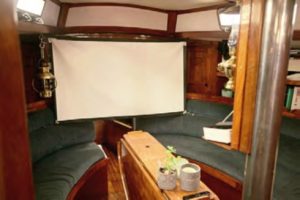
Hang the screen, set up the projector, and dim the lights: On Avocet, these are the three steps required to binge a favorite Netflix series.
The projector project began with the urge to banish something they didn’t like—a rather unbecoming lamp, complete with a shade, attached to the compression post.
“It looked out of place and was one of the first things Chris removed,” Marissa says. “To replace it, he built a teak box that wrapped partially around the post where we could hang our gimbaled oil lamp.”

The newly built fixture around the compression post holds an oil lamp and a small box that, when open, creates a shelf for a movie projector.
They decided to make the box serve dual purposes: Just below the lamp, Chris built a small box that holds a firewire remote and wiring for a projector. The front of the box unlatches and opens to create a small shelf, where they can place the projector and watch movies on a screen on the forward bulkhead. It’s a perfect setup for binging a Netflix series, Marissa says. Chris also installed USB outlets in the nearby galley table so the projector can be plugged in there, which means no unnecessary extension cords.
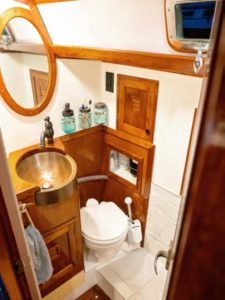
The finished head, with copper sink and new toilet to one side. A curtain that hangs in the middle of this space creates a designated showering area, to the right.
But hands-down, Marissa says, the best thing they’ve done aboard Avocet is reconfiguring the head. When someone would shower in the old head, everything got wet.
“With so many cracks, crevasses, and hiding spots, the mold would have been inevitable, so we didn’t use the shower,” Marissa says.
After considerable internet research and careful design consideration, the couple reconfigured the head so the showering area is isolated from the sink and toilet by a curtain, creating standing room to shower without getting the other fixtures wet. The new head incorporates visual design elements including a copper sink, a bronze cleat towel holder, and a tiled backsplash. Marissa finished the room with Tile Clad HS, a two-component epoxy polyamide coating paint that she says is “bulletproof” and helps in the battle against mold.
“Now the head is easy to clean, easy to use, and simple to fix—the perfect trifecta as far as boat projects go,” Marissa says.

The original quarter berth was set up at two levels for offshore, off-watch sleeping. The lower level also served as the seat for the nav station.
“Simple to fix” is a bit of a mantra aboard Avocet. Marissa and Chris make sure that every project they tackle is easily modified or (within reason) easily dismantled for maintenance or replacement, or to get at what’s behind the project.
“Don’t ever fool yourself into thinking that once a project is complete, you will never need to do it again,” Marissa says. “Unfortunately, problems on a boat go unnoticed for so long because the access to many areas is so bad.”
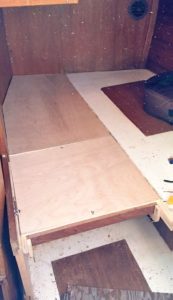
To create the queen-sized berth, the Neelys raised the lower to match the upper bunk’s height. They left a small section at the lower level to continue serving as the nav seat when the berth isn’t in use.
One of the simpler projects they tackled was converting a stepped quarter berth on Avocet into a queen-sized berth. The stepped arrangement—essentially two single berths, side-by-side, one higher than the other—was designed for crew trying to sleep on the off watch while underway. Marissa and Chris are more realistic about the type of sailing Avocet will be doing, at least in the short term, and wanted to be able to host other couples for the night without making them sleep as though on bunk beds.
After disassembling some of the upper bunk, Chris cleaned and painted the four storage lockers below the berths and made one of them into a dedicated electronics locker. Then, using ½-inch plywood and strips of wood 2 inches thick, he framed the new lower bunk to match the height of the upper.
When he raised the bunk, he was also effectively raising the height of the nav station seat, since in the previous configuration, the end of the lower bunk doubled as the seat. To solve this problem, he left the end of the new bunk at the old level, trimming around it so that the “new” seat now had a nice backrest. When the bunk is going to be used, the seat is raised like an insert and completes the queen-sized space.
When the space was finally ready for a mattress, they dismissed the idea of buying something custom and ordered a latex foam mattress from Amazon.
“After measuring and remeasuring a few hundred times,” Chris says, “I found that a queen size was the smallest we could go. I also found that using a very sharp knife works perfectly for cutting this type of mattress.”
Now they have a berth in which two can sleep side-by-side, and they’ve increased the volume of the available storage underneath.
Marissa has advice for anyone considering tackling a long-dreaded project: “The first step is identifying the cause of a particular issue, and then coming up with a fix—while simultaneously understanding that there will be snags along the way. Timelines will take longer than anticipated. But if you budget for the side projects, mishaps, and other surprises, it won’t be nearly as frustrating. The key is to plan for the unplannable. Take every project step-by-step and set a new goal each day. And always remember that Rome wasn’t built in a day, and neither were sailboats!”
Yahtzee
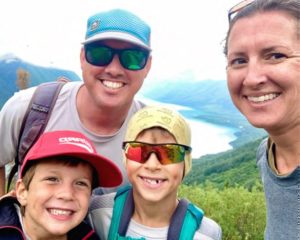
Andy and Jill Cross and their sons, Magnus and Porter.
For the Cross family—Andy and Jill and their sons, Porter and Magnus—whose homeport is Seward, Alaska, some of the early sailing they did helped dictate the initial modifications aboard Yahtzee, their 1984 Grand Soleil 39. Much of that sailing was in the frigid waters of Alaska, and they gunkholed in and around British Columbia and explored the coast of Washington State.

Once he’d cut the StarBoard to size, Andy and friends used heat guns and ratchet straps to pull the piece into position, then fasten it into place.
“For us, having a quality dodger is a must, especially when cruising in higher latitudes,” Andy says. “The Sunbrella dodger that came with the boat was tired and needed to be replaced, but I wasn’t satisfied going with canvas again, and some of the quotes I got were outrageous. I set about designing and building my own hard dodger.”
Using King StarBoard for the top and Lexan for the windshield, Andy did a lot of templating as he built the dodger.
“I had to make sure my numbers and cuts were true, because not getting it right the first time could quickly get very expensive.”

The finished hard dodger with Lexan windows and stainless steel grab rails.
Andy started by cutting and shaping the stainless steel frame of the original dodger until he achieved the overall look he was after, and then he made a template for the top out of thin plywood. He repeated the process for the windshield pieces. After he replicated the top in StarBoard, he used a router to soften the edges, fastened the piece into place, and then he and several buddies used heat guns and ratchet straps to pull the StarBoard into the shape he desired over the frame.
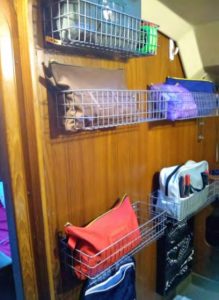
After trying several other organization systems in the tool room, the plastic-coated wire baskets that Jill found have proven invaluable.
“It worked brilliantly!” Andy says. “The biggest trial-and-error came in cutting and shaping the Lexan. I had to make many templates to achieve the right curves so it would not only fit, but look good, too.”
Another big change was decommissioning one of their boat’s two heads and using it for much-needed storage. Over time, Andy found that most of his tools had migrated to Yahtzee’s forward head, and not in a way that was organized. Finding and retrieving them was a hassle. They decided to convert the space into a dedicated tool room.
Building out the space was an organic, years-long process of trying different storage systems and setups, watching them fail, and reinventing accordingly.
“We tried canvas hanging storage bins, and that worked for a while,” Andy says. “But eventually they became deformed. Then Jill came across these wire storage bins that are covered in a strong, plastic coating. We mounted the bins, put my tools in canvas bags, and then organized the bags on the shelves in a way that made sense. Nothing slides around or falls out. Now I can’t imagine not having this room.”
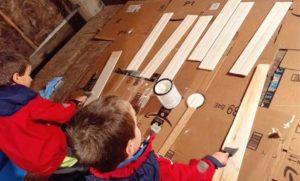
The Cross boys—Porter and Magnus—are pressed into service painting tongue-and-groove pine that has already been cut to size and is ready to be installed.
Of course, not all modifications arise out of pure necessity.
“For the headliner project, it was simply an out-with-the-old, in-with-the new situation,” Andy says. “The old headliner was plywood wrapped in some type of faux leather-ish cloth. It was badly discolored in spots and sagged in others. In general, it didn’t look very good. We also needed to upgrade all the lighting to better LEDs, so I tackled both projects at the same time.”
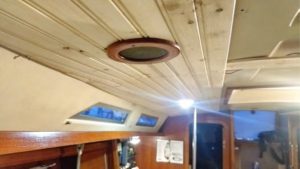
Andy used inexpensive pine tongue-and-groove he sourced at a local big-box store to replace an old, saggy headliner.
After researching online, Andy discovered someone who had replaced his headliner with inexpensive pine tongue-and-groove planking carried at Lowe’s or Home Depot. He bought some and did a test headliner in the port aft cabin. Liking how easy it was to work with and how it turned out, Andy decided to replace every headliner in the boat with this material.
“We were living in a small cabin in Alaska for the winter, so I turned the inside of the boat into a woodshop. The real difficulty was figuring out the angles on the sides, as the cabin narrows moving forward. Fortunately, the pine planking was cheap, so I was able to make some test cuts and mock-ups before I created the real pieces.” He finished the new headliners with white Interlux interior paint.
“Overall, I’m extremely happy with how it turned out,” he says. “The bright-white painted planking, combined with the new LED lighting, looks much better and brightens up the cabin a lot. And remarkably, the new headliner actually added about an inch to the overall headroom in the boat!”
Emerald
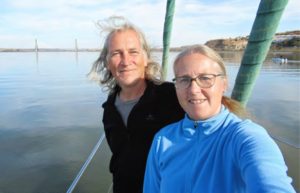
Colin and Nichola Wright aboard Emerald.
The first major project aboard Nichola and Colin Wright’s 1979 Kelly Peterson 44, Emerald, had everything to do with comfort—that is, with keeping them warm during a British winter. Initially they made “a rushed decision” to install an Eberspächer forced-air heating system, but it was plagued with problems and breakdowns.

The space the Wrights chose to install the Refleks
heater was a large cupboard in the corner of the main
saloon.
Then a marina neighbor alerted the Wrights to a used Refleks diesel heater for sale.
“It was currently installed on a canal boat, priced at about $500, which was a fraction of the new price of around $3,000,” Nichola says. “As a bonus, it had been modified with the addition of a Lockgate high-volume water jacket. That meant the heater would warm water that could then be pumped to other locations, such as a radiator.”
The couple picked out a spot against the forward bulkhead and rolled up their sleeves. Cutting away the teak panels of the locker where the stove would go was a daunting prospect. They had the presence of mind, however, to preserve the panels to repurpose them for custom cabinetry around their new stove.

The finished heater installation. Note that some of the electronics that had previously lived in the old space have been moved to the new cabinetry.
Once they’d created a space large enough to accommodate the stove and chimney, Nichola and Colin fireproofed the area by installing a base of Welsh slate donated by her Uncle Howard. Then they covered the walls adjacent to the stove and pipe with cement board and finished these surfaces with green glass tile, to match the color in the rest of the boat’s interior.
Two of the biggest challenges were cutting the slate to size, and drilling holes in it for mounting the stove. The most anxious moment, though, was cutting the nearly 4-inch exit hole for the chimney through their cabin roof. The location had to be right, of course, and the aperture had to be leak-proof.
After roughing-out an opening through the cabin top and fitting it with a 1-inch-thick piece of teak that they sealed to the deck using 1,200-degree silicon flue sealant, the Wrights installed a stainless steel Refleks flange. When they don’t need the stove and want to remove the stack (it’s stored in a heavy-duty waterproof bag in the bilge when not in use), a cap seals the flange against the weather.
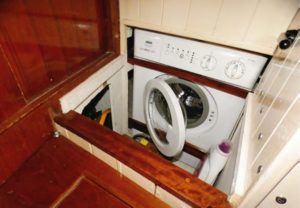
With the wash area’s tabletop removed, the washing machine is exposed in a small alcove.
The heater came with a 13-gallon diesel tank that Nichola and Colin sited adjacent to and above the heater for a gravity feed. As a backup, a dedicated pump also can move diesel from the main tanks aboard Emerald to the heater tank.
Several small radiators are connected to the water jacket on the Refleks heater with insulated copper tubing. A Jabsco circulation pump feeds the heated water through the tubes to the radiators, ensuring that the more remote locations aboard—like the aft cabin, where Nichola and Colin sleep—stay nice and toasty.
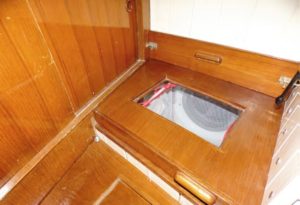
With the wash area’s tabletop in place, a small hatch allows dirty laundry to be dropped into the hamper.
Like the Cross family, Colin and Nichola found that having two heads was overkill, and since they had never intended to use the aft head for its given purpose, it just started becoming a catch-all storage area.
“The aft head eventually filled up with stuff that didn’t have another home, including an Avon inflatable dinghy,” Nichola says. It got so bad that they couldn’t open the head door without putting out an arm to catch anything that might fall.
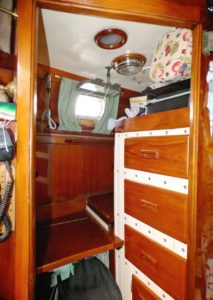
The aft head was redesigned to include a dressing area with storage, the washing machine (located beyond the cupboards, not visible in this image), and a desk/ dressing table.
Then, after buying a small washing machine and successfully setting it up in their cockpit (it was a long way to the nearest laundromat, and they didn’t have a car), it occurred to them that they might be able to reconfigure the head to become a hybrid laundry and walk-in closet space.
Out came the Avon, which they sold at a price that covered the cost of the entire renovation (including the washing machine), and out came the Groco K series toilet, which they stripped for parts.
Reconfiguring a locker adjacent to the head, they created a space where the washing machine could be installed, with the door opening into the head. Colin used marine-grade plywood and lengths of pine tongue-and-groove to build the machine’s enclosure and the cabinetry around it. On top, a removable board has an opening cut into it under which a hamper hangs; when they want full access to the machine, they simply remove that board.

Nichola sews new covers in the cockpit using a vintage Singer 201k sewing machine.
In the remainder of the head, since there were so few horizontal surfaces in the aft cabin, they built a storage area with deep drawers and a desk/dressing table on top.
“One snag we hit was the weight and size of the machine,” Nichola says. “It took three men to manhandle it in through the aft companionway. To get it through we had to remove the outer casing of the machine as well as the frame of the door to the head.”
Nichola says the change has made them more self-sufficient at anchor. Emerald’s watermaker supplies the 9 gallons of cold water the machine needs to wash a load, and a solar array, coupled to an inverter, provides the necessary power.

Cushions lined up on the saloon berth. Fabric material includes Ikat, Rona tartan, and Harris tweed.
There are small projects, too, that aim for comfort on Emerald. By making throw pillows of fabrics from the many places they have visited, Nichola has created a living space that evokes the essence of some of their travels.
“I like a cozy home,” Nichola says. “Emerald’s saloon berths consist of thick, foam cushions set at 90 degrees to each other. Fine for short trips and holidays, but not the most comfy for sitting on long-term. Throw pillows seemed like a simple solution.”
So far, to cover the pillows she’s used material from England, Scotland, Spain, and Tunisia, to name a few. The materials themselves have included tea towels, tartan-patterned bolts of cloth, and yarn (obviously, a fair amount of knitting was involved).
“I can never have too many cushions,” Nichola says. “The teak wood interior is lovely, but sometimes it makes the saloon seem a little dark. So, beyond them being practical, cushions add a welcome splash of color.”
Chris and Marissa Neely have been living aboard and upgrading their 1979 Cheoy Lee 41, Avocet, since 2018. Primarily they sail in and around Southern California’s Channel Islands. Follow them at svavocet.com, on other social platforms at @svavocet, and on their YouTube channel called Sailing Avocet.
The Cross family is exploring the western Pacific coastline, from Alaska to Panama, aboard Yahtzee, their 1984 Grand Soleil 39. Andy is the editor of 48° North magazine and can be found racing and teaching sailing in his spare time. Follow their adventures at sailingyahtzee.com or via Facebook (facebook.com/sailingyahtzee).
Nichola and Colin Wright met in 2003 and moved aboard Emerald, their Peterson 44, a year later. Since then they’ve circumnav¬igated England, sailed to Denmark and Sweden, and explored much of the Med, cruising as far east as Turkey. Follow them at yachtemerald.com, facebook.com/yachtem¬erald, and instagram.com/sailingemerald.
Thank you to Sailrite Enterprises, Inc., for providing free access to back issues of Good Old Boat through intellectual property rights. Sailrite.com

